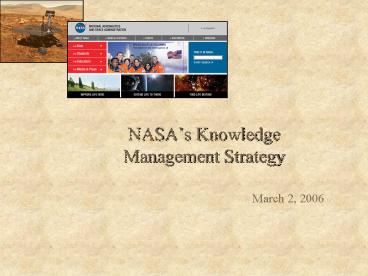NASAs Knowledge Management Strategy - PowerPoint PPT Presentation
1 / 6
Title:
NASAs Knowledge Management Strategy
Description:
... and share the knowledge we already have. Efficiently manage NASA's knowledge resources ... Federal KM Working Group--Knowledge and Human Capital Retention ... – PowerPoint PPT presentation
Number of Views:64
Avg rating:3.0/5.0
Title: NASAs Knowledge Management Strategy
1
NASAs Knowledge Management Strategy
- March 2, 2006
2
Key Areas for NASAs KM Strategy
- Increase collaboration and to facilitate
knowledge creation and sharing - Develop techniques and tools to enable teams and
communities to collaborate across the barriers of
time and space
3
Framework for KM at NASA
Sharing and Using Knowledge
People
Process
Technology
- Enliven collaboration
- Facilitate communities of practice
- Reward and recognize knowledge sharing
- Encourage storytelling
- Drive a One NASA culture
- Create end-to-end focus in disciplines
- Enhance knowledge capture
- Accelerate learning
- Manage information
- Enhance system integration and access
- Deploy intelligent agents for people
- Exploit semantic technologies
- Reuse existing capabilities in new ways
Supporting Activities
Education and Training
Human Resources
IT Infrastructure
Security
4
Critical KM Activities at NASA
5
Looking Ahead
- We are working on a variety of new initiatives
that are still being formulated, including - Accelerating learning
- Integrated approach to e-learning and support to
the project managers - NASA Engineering Network
- Customizable, organized access to information
across distributed resources - Allow easy, secured collaboration across project
partners - Finding experts and expertise to facilitate
sharing knowledge person-to-person via social
networks - Embed lessons and expertise into policies and
processes--360º learning - Sharing knowledge with partners for NASAs
success - International Astronautical Federation (IAF)
Working Group on KM for Aerospace - Federal KM Working Group--Knowledge and Human
Capital Retention - Access information at http//km.nasa.gov
6
Knowledge Management Roadmap
Modeling Expert Knowledge
- Systems model experts patterns and behaviors to
gather knowledge implicitly - Seamless knowledge exchange with robotic
explorers - Planetary explorers contribute to their
successors design from experience and synthesis - Knowledge systems collaborate with experts for
new research
Capturing Knowledge
- Knowledge gathered anyplace from hand-held
devices using standard formats on interplanetary
Internet - Expert systems on spacecraft analyze and upload
data - Autonomous agents operate across existing sensor
and telemetry products - Industry and academia supply spacecraft parts
based on collaborative designs derived from
NASAs knowledge system
Integrating Distributed Knowledge
- Instrument design is semi-automatic based on
knowledge repositories - Mission software auto-instantiates based on
unique mission parameters - KM principals are part of NASA culture and
supported by layered COTS products - Remote data management allows spacecraft to
self-command
Enables real-time capture of tacit knowledge from
experts on Earth and in permanent outposts
Sharing Knowledge
- Adaptive knowledge infrastructure is in place
- Knowledge resources identified and shared
appropriately - Timely knowledge gets to the right person to make
decisions - Intelligent tools for authoring through archiving
- Cohesive knowledge development between NASA, its
partners, and customers
- Interstellar missions
- Permanent lunar and Martian colonies
Enables capture of knowledge at the point of
origin, human or robotic, without invasive
technology
Enables seamless integration of systems
throughout the world and with robotic spacecraft
- Mars robotic outposts
- Comet Nucleus Sample Return
- Saturn Ring Observer
- Terrestrial Planet Finder
Enables sharing of essential knowledge to
complete Agency tasks
- Europa Lander/Submersible
- Titan Organics Lander/Aerobot
- Neptune Orbiter/Triton Observer
- MarsNet
- Mars Exploration Rovers
- Space Interferometry Mission
2003
2007
2010
2025































